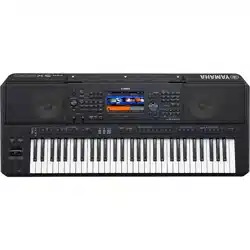Documents: Go to download!
- Owner's manual - (English, French)
Owner’s Manual Digital Workstation Yamaha PSR-SX900
Table of contents
- Precautions
- Main Features
- Included Accessories
- About the Manuals
- Using the PSR-SX900/SX700—A Broad Overview
- Key Functions and Terms
- Panel Controls and Terminals
- Starting Up
- Power Supply
- Turning the Power On/Off
- Making Basic Settings
- Changing the Brightness of the Main Display and Button Lamps
- Display Structure
- Main Display Structure
- Basic Operations
- Display Configuration
- Closing the Current Display
- Display-based Controls
- Calling up the Desired Display Instantly—Direct Access
- Playing the Demos
- File Management
- Entering Characters
- Locking the Panel Settings (Panel Lock)
- Using the Metronome
- Workflow Guide—For Performing on the PSR-SX900/SX700
- Operation
- Guide
- Playing with Styles—Setting Up
- Setting up Styles
- Optimum Panel Settings for the Current Style (One Touch Setting)
- Setting up Keyboard Parts
- Selecting a Voice for Each Keyboard Part
- Creating Original Organ Flutes Voices
- Setting up Keyboard Harmony/Arpeggio
- Setting up Multi Pads
- Memorizing Original Panel Settings to One Touch Setting
- Changing the Pitch of the Keyboard
- Setting up Assignable Controllers
- Operation
- Guide
- Playing with Styles—Operations While Performing
- Operating Style Playback
- Recording and Playing Back a Chord Sequence—Chord Looper (PSR-SX900)
- Expressively Controlling Your Performance
- Playing and Controlling Super Articulation Voices
- Controlling Multi Pad Playback
- Operation
- Guide
- Singing with Song Playback—Setting Up
CAUTION
Always follow the basic precautions listed below to avoid the possibility of physical injury to you or others, or damage to the instrument or other property. These precautions include, but are not limited to, the following:
Power supply/AC adaptor
- Do not connect the instrument to an electrical outlet using a multipleconnector. Doing so can result in lower sound quality, or possibly cause overheating in the outlet.
- When removing the electric plug from the instrument or an outlet, always hold the plug itself and not the cord. Pulling by the cord can damage it.
- Remove the electric plug from the outlet when the instrument is not to be used for extended periods of time, or during electrical storms.
Location
- Do not place the instrument in an unstable position where it might accidentally fall over.
- Before moving the instrument, remove all connected cables, to prevent damage to the cables or injury to anyone who might trip over them.
- When setting up the product, make sure that the AC outlet you are using is easily accessible. If some trouble or malfunction occurs, immediately turn off the power switch and disconnect the plug from the outlet. Even when the power switch is turned off, electricity is still flowing to the product at the minimum level. When you are not using the product for a long time, make sure to unplug the power cord from the wall AC outlet.
Connections
- Before connecting the instrument to other electronic components, turn off the power for all components. Before turning the power on or off for all components, set all volume levels to minimum.
- Be sure to set the volumes of all components at their minimum levels and gradually raise the volume controls while playing the instrument to set the desired listening level.
Handing caution
- Do not insert a finger or hand in any gaps on the instrument.
- Never insert or drop paper, metallic, or other objects into the gaps on the panel or keyboard. This could cause physical injury to you or others, damage to the instrument or other property, or operational failure.
- Do not rest your weight on, or place heavy objects on the instrument, and do not use excessive force on the buttons, switches or connectors.
- Do not use the instrument/device or headphones for a long period of time at a high or uncomfortable volume level, since this can cause permanent hearing loss. If you experience any hearing loss or ringing in the ears, consult a physician
See other models: P-37D P-25F GC2 CSP-170 PSR-S775
